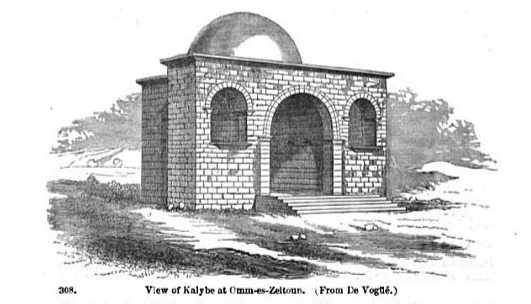Kalybe (temple) on:
[Wikipedia]
[Google]
[Amazon]
 A kalybe (κάλὑβη) القليب is a type of
A kalybe (κάλὑβη) القليب is a type of
 A kalybe (κάλὑβη) القليب is a type of
A kalybe (κάλὑβη) القليب is a type of temple
A temple (from the Latin ) is a building reserved for spiritual rituals and activities such as prayer and sacrifice. Religions which erect temples include Christianity (whose temples are typically called churches), Hinduism (whose temples ...
found in the Roman East dating from the first century
The 1st century was the century spanning AD 1 ( I) through AD 100 ( C) according to the Julian calendar. It is often written as the or to distinguish it from the 1st century BC (or BCE) which preceded it. The 1st century is considered part of t ...
and after. They were intended to serve as a "public facade or stage-setting, solely for the display of statuary." " ey were essentially stage-sets for ritual enacted ''in front'' of them." The kalybe has been associated with the Roman imperial cult
The Roman imperial cult identified emperors and some members of their families with the divinely sanctioned authority (''auctoritas'') of the Roman State. Its framework was based on Roman and Greek precedents, and was formulated during the early ...
.
The first kalybe to be identified as a distinct type was in Umm Iz-Zetun (or Zetum),For one modern spelling of the toponym. described by Eugène-Melchior de Vogüé
Marie-Eugène-Melchior, vicomte de Vogüé (25 February 1848 – 29 March 1910) was a French diplomat, Orientalist, travel writer, archaeologist, philanthropist and literary critic.
Biography
Born in Nice, France, he served in the Franco-Prussi ...
in 1867. Together with the temple he found two Greek inscriptions describing the structure as a "kalybe." Other than these, the only occurrence of the term is in a lexicon of Hesychius of Alexandria
Hesychius of Alexandria ( grc, Ἡσύχιος ὁ Ἀλεξανδρεύς, Hēsýchios ho Alexandreús, lit=Hesychios the Alexandrian) was a Greek grammarian who, probably in the 5th or 6th century AD,E. Dickey, Ancient Greek Scholarship (2007) ...
from the fifth century, Since that time more than seven similar temples have been identified in Roman Syria. In addition to Umm Iz-Zetum these include Shaqqa (''Saccaea''), Il-Haiyat, Shahba
Shahba ( ar, شَهْبَا / ALA-LC: ''Shahbā'') is a city located south of Damascus in the Jabal el Druze in As-Suwayda Governorate of Syria, but formerly in the Roman province of Arabia Petraea. Known in Late Antiquity as Philippopolis (in ...
(''Philippopolis'') (built around 245 by the Emperor Philip the Arab
Philip the Arab ( la, Marcus Julius Philippus "Arabs"; 204 – September 249) was Roman emperor from 244 to 249. He was born in Aurantis, Arabia, in a city situated in modern-day Syria. After the death of Gordian III in February 244, Philip ...
), Qanawat
Qanawat ( ar, قَنَوَات, Qanawāt) is a village in Syria, located 7 km north-east of al-Suwayda. It stands at an elevation of about 1,200 m, near a river and surrounded by woods. Its inhabitants are entirely from the Druze comm ...
(''Kanatha''), Bosra
Bosra ( ar, بُصْرَىٰ, Buṣrā), also spelled Bostra, Busrana, Bozrah, Bozra and officially called Busra al-Sham ( ar, بُصْرَىٰ ٱلشَّام, Buṣrā al-Shām), is a town in southern Syria, administratively belonging to the Dara ...
(''Bostra''), Amman
Amman (; ar, عَمَّان, ' ; Ammonite language, Ammonite: 𐤓𐤁𐤕 𐤏𐤌𐤍 ''Rabat ʻAmān'') is the capital and largest city of Jordan, and the country's economic, political, and cultural center. With a population of 4,061,150 a ...
(''Philadelphia '') and Hippos
A hippo or hippopotamus is either of two species of large African mammal which live mainly in and near water:
* Hippopotamus
* Pygmy hippopotamus
Hippo or Hippos may also refer to:
Toponymy
* The ancient city of Hippo Regius (modern Annaba, Al ...
.
Kalybes were built facing a square or plaza where worshipers could gather. It is believed they were influenced by Nabataean
The Nabataeans or Nabateans (; Nabataean Aramaic: , , vocalized as ; Arabic: , , singular , ; compare grc, Ναβαταῖος, translit=Nabataîos; la, Nabataeus) were an ancient Arab people who inhabited northern Arabia and the southern Lev ...
designs. Possibly the oldest, at Bosra, was built in the late first century
The 1st century was the century spanning AD 1 ( I) through AD 100 ( C) according to the Julian calendar. It is often written as the or to distinguish it from the 1st century BC (or BCE) which preceded it. The 1st century is considered part of t ...
when Bosra was the capital of the Nabataean kingdom under Rabbel II Soter
Rabbel II Soter (Nabataean Aramaic: ''Rabʾel dī ʾaḥyēy wa-šēzīb ʿammeh'', "Rabbel, who gave life and deliverance to his people") was the last ruler of the Nabataean Kingdom, ruling from 70 to 106.
After the death of his father, Malic ...
. Their form most resembles the rock-cut temples at Petra
Petra ( ar, ٱلْبَتْرَاء, Al-Batrāʾ; grc, Πέτρα, "Rock", Nabataean Aramaic, Nabataean: ), originally known to its inhabitants as Raqmu or Raqēmō, is an historic and archaeological city in southern Jordan. It is adjacent to t ...
, and most have been found in cities that were formerly part of the Nabataean kingdom.
References
Ancient Roman buildings and structures 2nd-century religious buildings and structures 3rd-century religious buildings and structures {{struct-type-stub